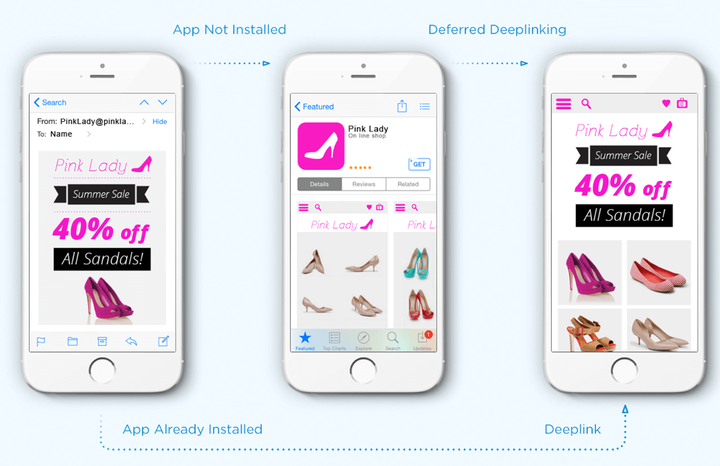
How to attribute data through Web to App(W2A)
- 2025.07.15 17:43
- openinstall
- Product Dynamics
In recent years, traditional app store promotion has faced diminishing marginal returns, while social media advertising struggles with fragmented user attention. In contrast, Web to App(W2A) emerges as the optimal choice for developers seeking diversified product promotion and high revenue growth.
Through the Web to App model, developers can design web frontends to gradually guide users in exploring brand information. Web-based promotion directly reaches users at early stages, offering core feature experiences and user screening. This approach enables more precise user conversion and greater content flexibility.
This article introduces the feasibility of openinstall’s Web to App solution, addressing attribution tracking challenges in web-to-app promotion and highlighting five unique advantages to demonstrate the value of this attribution solution.
Breaking Through with Web to App(W2A)
Amid difficulties in app store user acquisition and saturated traffic, openinstall’s Web to App solution offers developers a flexible alternative for rapid market entry. Key benefits include customizing download details (e.g., APK downloads), establishing direct browser-to-app user connections, and leveraging broader traffic pools for user acquisition.

The core challenge of Web to App lies in tracking user journeys from web visits to conversion events to optimize campaigns and product strategies. For small-to-medium teams, fragmented data between web interactions (limited device info) and post-install app behavior creates “web page ➡ in-app action” data silos.
openinstall solves this through its parameterized attribution workflow:
- User visits H5 landing page: openinstall’s web SDK captures custom parameters and essential data.
- Post-install attribution: Upon first app launch (or direct deep linking for existing users), parameters are retrieved for attribution.
- Dynamic customization: Developers can append parameters to links for features like codeless referral tracking, contextual deep linking, and customized analytics. openinstall auto-generates reports on channel visits, installs, and more, while supporting custom metrics.
![]()
With openinstall’s precise tracking, Web to App campaigns eliminate operational uncertainties. Whether collaborating with KOLs, running multi-channel promotions, building websites, or launching SMS/social media campaigns, developers can measure channel ROI, bridge web-to-app event data, and establish new growth pathways.
Five Advantages of Web to App(W2A)
1. Enhanced Engagement & Interactivity
Web pages excel as interactive ad platforms. Unlike static ads, Web to App migrates app content to the web, enabling gamification, UGC formats, videos, and animations to drive downloads.
- Content apps (e.g., short dramas, novels): Preview chapters on landing pages, then gate key content behind app downloads.
- Utility apps: Offer basic web features while reserving core functionalities (e.g., test results) for the app experience.
2. Deep Linking Personalization
Deep linking tailors experiences across app categories:
E-commerce apps: Display products on web pages, then guide users to download for cart/checkout actions. openinstall’s deep linking directs users straight to in-app product pages, eliminating search friction.

3. Granular Data Insights
Web to App enables flexible data collection (with user consent) via openinstall’s parameter tracking, capturing web activity and source data for campaign optimization. Self-attribution setups (e.g., Facebook/Google Ads) allow parameter feedback to ad platforms, refining targeting models.
4. Reduced Store Dependency
As app store review barriers escalate, Web to App minimizes platform reliance, lowering operational costs and bypassing store revenue cuts—empowering SMEs to compete effectively.
5. Expanded User Reach
Web’s broader reach engages app-averse users via functional previews. Unlike platform-locked ads, web campaigns deploy across diverse scenarios: SMS, email, KOL partnerships, live streams, QR codes, offline posters, and more—all trackable via openinstall’s multi-channel analytics.
In an era of tightening app store policies and stagnating growth, Web to App offers a strategic alternative. Instead of battling store algorithms, developers can adopt openinstall’s web-to-app parameter solution to seize market opportunities swiftly.
Recent Posts
- OpenInstall Omnichannel Multi-scenario Solution
- Having trouble acquiring users and achieving conversions for your app? Here are solutions based on real-world examples.
- openinstall: A solution for attribution and redirection from web to app (W2A).
- How to efficiently use app data statistics
- In today’s wave of social networks, how should developers make good use of omni-channel statistics?
- ASA Attribution Statistics: Breaking Through the Gap in iOS Customer Acquisition Data from a Developer’s Perspective, Making Advertising Decisions More Traceable
- Openinstall Core Function Usage Guid
- What benefits can a Web to App attribution solution bring?
- IMore than just “data calculation”: The underlying logic of APP channel agent statistics is the key to doubling conversion efficiency
- How to Use App Install Parameters for Channel Attribution



